Use 'Print preview' to check the number of pages and printer settings.
Print functionality varies between browsers.
Printable page generated Friday, 21 November 2025, 5:50 AM
Adolescent and Youth Reproductive Health Module: 7. Substance Abuse
Session 7 Substance Abuse
Introduction
There are many interrelated factors that affect the sexual and reproductive health of young people in Ethiopia. In Study Sessions 3–6 of this module you have learned about some of the major problems that affect young people’s sexual and reproductive health. In this session you will learn how young people’s sexual and reproductive health can be affected by the use of substances like alcohol, khat, cannabis and cigarettes. There are some direct effects on sexual and reproductive functions but there are also important indirect effects whereby the abuse of substances are shown to be strongly associated with risk-taking behaviours that impact negatively on sexual and reproductive health.
Learning Outcomes for Study Session 7
When you have studied this session, you should be able to:
7.1 Define and use correctly all of the key words printed in bold. (SAQs 7.1 and 7.2)
7.2 Describe the types of substances that can be abused and the adverse effects they can have on sexual and reproductive health. (SAQ 7.1)
7.3 Explain why some young people abuse substances. (SAQ 7.2)
7.4 Describe your role in preventing substance abuse. (SAQ 7.3)
7.1 Substance Abuse
As you learned in Study Session 2 of this module, adolescents and young people are vulnerable to many health problems because of their risk-taking behaviour. They tend to experiment with substances without fully understanding what the consequences are likely to be for their future life and health. In particular their curiosity and peer pressure can lead to their experimenting with psychoactive substances. A psychoactive substance affects the functions of the brain, altering mood and distorting perception. A consequence of this is that the person’s behaviour changes. Repeated use of psychoactive substances can result in substance abuse Substance abuse is defined as a pattern of harmful use of any mood-altering substance. When a person becomes unable to function normally without using these substances, they are described as being addicted or dependent on the substance.
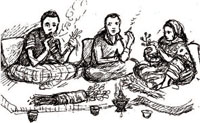
Substances that could induce dependence are numerous and include substances that are popular with young people, such as: alcohol (e.g. Tella, Tej, Arakie, Beer), khat, nicotine (found in tobacco and cigarettes), cannabis (marijuana or hashish), cocaine, heroin and petrol fumes (Figure 7.1). These substances are categorised as: 1) Licit: those which are not regulated or prohibited and 2) Illicit: those which are prohibited by law. The substances which are not prohibited by law include alcohol, khat, tobacco, cigarettes and coffee. The substances restricted by regulations include cannabis (marijuana or hashish), cocaine and heroin.
You will learn in detail about substance abuse in Study Session 14 of the Non Communicable Disease, Part 2 Module in the mental health section; here you will learn a little bit about psychoactive substances that can be abused and the consequences of substance abuse on the health of young people. Also you will find out some of the reasons why young people are tempted to try psychoactive substances and the ways in which you can work in your community to try to prevent substance abuse.
7.1.1 Alcohol
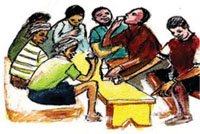
The effects of alcohol are noticeable in all spheres (physical, psychological, social, and economic) of the lives of alcohol drinkers. Alcohol has immediate effects leading to intoxication (drunkenness), and long-term effects which can include addiction. Many years of heavy alcohol use can lead to chronic diseases and early death. Alcohol is a major avoidable risk factor for cardio-vascular disease, liver disease and cancer. It is also associated with STIs, including HIV, and unwanted pregnancy because alcoholic intoxication leads to risky sexual behaviour. Alcoholic intoxication is also the cause of violent behaviour and accidents, which can result in deaths and disability and intoxicated young people are also predisposed to commit suicide.
Stop reading for a moment and think whether you know any young person in your community who is affected by alcohol? In what ways is this person affected? Who else is affected by their behaviour?
If you know of a young person who is inclined to drink too much or is very often drunk you might have had the thought that the effects of alcohol go beyond the individual drinker. The drinker’s behaviour can affect other family members and the community. Some of these adverse effects are presented in Table 7.1.
| School | Family | Social | Legal |
|---|---|---|---|
| Inefficiency | Frequent fights | Distance from friends | Disobeying rules |
| Poor performance | Neglect of family duties | Misbehaviour with others | Thefts and petty crimes |
| Frequent absence | Physical violence with family members | Decreased social reputation | Involvement with criminal gangs |
| Accidents in school | Long absence and running away from home | Social isolation | Arrests and court cases |
| Suspension from school | Rejection | Constant borrowing | Conviction |
| Inability to return borrowed money | Imprisonment | ||
| Fights, quarrels, theft |
As you see from the table, alcohol use affects more than the health of the individual user; it has multiple effects on all aspects of the drinker’s life.
In what ways does alcohol affect sexual and reproductive health?
Alcohol consumption exposes the drinkers to risky sexual behaviours involving sexual intercourse without using a condom. When intoxicated young people are also more likely to indulge in casual sex (one night stands) with multiple partners and sex with prostitutes; again, they are unlikely to use a condom in these situations. Gender-based violence particularly sexual violence is more common among people who are under the influence of alcohol. Behaviours such as these make the drinkers (and those with whom they interact) vulnerable to HIV infection.
Alcohol affects sexual and reproductive health in less visible ways too. Excessive drinking can shrink the genitals. It can lead to infertility in men because it kills the cells that are producing sperm. It also makes a woman less fertile and she may have difficulty conceiving. If she does become pregnant she is at a greater than normal risk of miscarriage or bearing an underweight baby that is either stillborn or born pre-term. Alcoholic mothers have a very high risk (around 40%) of their child suffering from fetal alcohol syndrome. These children are mentally retarded and have other growth defects; they have heart and brain abnormalities and behavioural problems. Many have a somewhat strange facial expression (Figure 7.2).
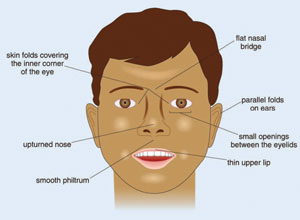
If a young person who has been drinking too much ceases their drink habit they should find their fertility is restored within a few months. A young woman who finds she is pregnant should stop drinking through the rest of her pregnancy, however, if she was drinking heavily when she conceived and in the weeks before she realised she was pregnant her baby’s brain may already be damaged. Maternal over consumption of alcohol is the major non-genetic cause of mental retardation.
7.1.2 Khat
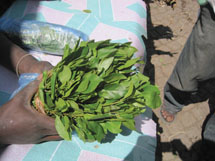
Khat is a plant grown in Ethiopia containing psychoactive substances that have a stimulant effect on the brain. This has been used for many years by Ethiopians for its ability to stimulate the brain so that the user does not feel tired or hungry. Ethiopians have commonly stuffed the leaves of the khat plant into their mouth and chewed whilst continuing to work. Khat consumption is widespread in Ethiopia and its use is increasing among young Ethiopians who may use it with others for recreation (see Figure 7.1). If they are gathered together socially, rather than working in the fields, the stimulant effect will make them feel excited and talkative.
Stop reading for a moment and think whether the young people in your community consume khat. What harmful effects of khat consumption have you observed among young people?
Although being talkative and not feeling tired may seem harmless the active substance in the khat leaves increases respiratory rate, heart rate and blood pressure all of which can cause long-term physical problems for some users. Not feeling tired can become a long-term problem where the user finds they are unable to sleep and this can result in mental problems such as depression or mania. The adverse effects of loss of appetite can include gastric irritation and constipation. As already mentioned, khat consumption alters the mood or emotional state of the users making them talkative and excitable. During this time of mood change khat users are more likely to engage in risky sexual behaviours that could expose them to HIV infection.
Long-term, over-use of khat can be addictive and it also reduces the desire to have sex.
There is more than one psychoactive ingredient in khat, the major substance found is called cathinone and it degrades and looses its power within 48 hours of the leaves being picked. This is why fresh leaves are preferred. However, khat leaves are also powdered and transported (for use in urban areas for example) and in this form the psychoactive ingredients are less powerful.
7.1.3 Tobacco and Cigarettes
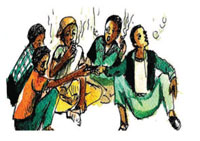
Tobacco is a plant originally grown in the Americas. The leaves are chewed or smoked in cigarettes or a pipe. Tobacco contains a psychoactive substance called nicotine which produces a feeling of happiness but can become addictive. Smoking tobacco also produces many other harmful substances such as tar, toxic chemicals similar to those found in hair dye and rat poison, and carbon monoxide. It is these substances that damage the smoker’s health. Some immediate effects of smoking include shortness of breath, coughing blood, lungs burnt by the chemicals in cigarettes. Smoking causes yellow teeth and nails, dull hair, and wrinkled skin.
Cigarette smoking harms nearly every organ of the body, causing many diseases and affecting the health of smokers in general. Cigarette smoking increases the risk for many types of cancer, including cancers of the lip, oral cavity, pharynx, esophagus, stomach, pancreas, larynx (voice box), lung, uterine cervix, urinary bladder, liver and kidney. But smokers are particularly at risk of dying from lung cancer.
Cigarette smoking causes reduced circulation by narrowing the blood vessels (arteries). This can lead to high blood pressure and heart diseases. Circulatory problems can also make it difficult for a man to obtain and maintain a penile erection. If he does get an erection he may reach orgasm too quickly or be unable to have an orgasm. High blood pressure seems to also affect male hormones, such as testosterone and low levels of testosterone affect his semen; he makes few sperm and those he does produce are of poor quality. His sperm have low motility and many are malformed.
Smoking also makes women less fertile and reduces their chance of conceiving. Smoking causes damage to the baby, they are underweight at birth and tend to have blood pressure problems later in life.
Passive smokers (non smokers who are exposed to the cigarette smoke from smokers), are also adversely affected and could develop the same health problems that smokers have. Passive smokers inhale and are affected by the same smoke containing cancer causing and poisonous chemicals. One in five young people in Ethiopia are exposed to passive smoking at home.
The vast majority of tobacco users and smokers are hooked when they are young. Once hooked, the majority of tobacco users become hopelessly addicted. Young people are easily influenced by peer pressure and advertising on cigarettes.
The great thing about quitting smoking is that the negative effects on sexual and reproductive health are rapidly reversed – including the effects on the unborn baby. The risk of developing the adverse effects (cancers, heart disease, chronic respiratory tract diseases) of cigarette smoking also reduces when smokers quit smoking. You should counsel and encourage young smokers to quit smoking. However you also need to acknowledge that it may be difficult for them to do this immediately. Many people who aim to quit are not successful the first time they try but will be successful later.
Nicotine is a psychoactive substance that can become addictive. An addict experiences withdrawal symptoms. When smokers quit smoking, they often experience one or more of the following withdrawal symptoms:
- A strong urge to smoke
- Feeling angry
- Feeling anxious
- Feeling depressed
- Finding it hard to concentrate
- Feeling headachy, restless or tired
- Feeling dizzy
- Chest pains, cough or nasal drip
- Being hungry or gaining weight
- Having trouble sleeping.
These symptoms are temporary, and they vary from person to person. During the first week, these symptoms may be strong and the chance of relapse is great. The following could help smokers after they quit smoking:
- Drinking a lot of water and fruit juice and avoiding drinks that contain caffeine or alcohol.
- Trying sugar-free gum or hard candies, or carrots.
- Staying busy: engaging in activities that are hard to combine with smoking
- Avoiding situations and places which the smoker strongly associates with the pleasure of smoking.
7.1.4 Cannabis (marijuana or hashish)
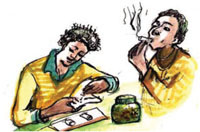
Cannabis is a plant grown in many parts of the world. A resin is prepared from the plants or the leaves are dried and smoked. They produce a happy feeling in most users, most times. The effect is relaxing but for some people using cannabis can result in feelings of anxiety or paranoia, described as having a “bad trip”. It is the most common illicit psychoactive substance used. Its use among young people in Ethiopia both in rural and urban areas is increasing.
Stop reading for a moment, do young people in your community use hashish? What adverse effects have you observed or heard of?
Smoking cannabis disrupts short-term memory. Long-term exposure to cannabis may produce long-lasting cognitive impairment. The risk of exacerbation of mental illness such as schizophrenia and bipolar disorder is associated with cannabis use. A link between cannabis use and ectopic pregnancy has been suggested but more certain is the link between cannabis use by men and their inability to have a satisfactory orgasm (they may reach orgasm too quickly or too slowly, if at all).
Cannabis users rapidly develop tolerance to most effects of cannabis. The user has tolerance when increased doses of the psychoactive substance are required in order to achieve effects originally produced by lower doses. As with cigarette smoking cannabis users may experience similar withdrawal symptoms when trying to quit.
7.2 Adverse consequences of substance abuse
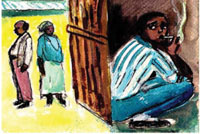
Substance abuse by young people can have economic, social, physical, psychological, and most importantly health consequences. Many of these have already been mentioned in relation to each specific substance.
What specific consequences of substance abuse in general are likely to affect young people’s sexual and reproductive health?
Some specific consequences of substance abuse you may have thought of are:
- All the psychoactive substances affect the mind and its rational decision making ability. Adolescents who use these substances could stop thinking rationally and may easily lapse into unsafe sexual practices that expose them to long term consequences like STIs, including HIV, and unwanted pregnancy.
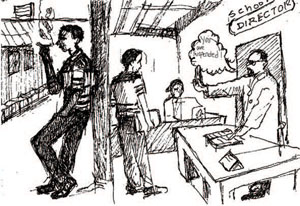 Figure 7.3 Substance use could lead to poor school performance and suspension from school.
Figure 7.3 Substance use could lead to poor school performance and suspension from school. - Substance abuse often leads to poor school performance. They are frequently absent from schools; they are violent in school, engage in fighting, and usually this results in their being suspended from schools because of their violent and aggressive behaviours. (Figure 7.3) Less education is associated with risky sexual practices.
- Relationships with parents, friends, and teachers could be affected. Young people who abuse substances may neglect family duties and engage in frequent violence; fighting with family members or with their friends; their social reputation is reduced. Without support from family and friends they may indulge in risky sexual behaviour, for example visiting prostitutes.
- Many psychoactive substances are expensive, an adolescent who uses these drugs needs to find the means to get money to buy them. This leads to stealing, dealing in drugs or becoming a prostitute to get enough money to buy drugs. They often break rules or commit crimes as a result of which they could be arrested and imprisoned.
- All the psychoactive substances affect the mind and its rational decision making ability. Adolescents who use these substances could stop thinking rationally and may easily lapse into unsafe sexual practices that expose them to long term consequences like STIs, including HIV, and unwanted pregnancy.
7.3 Reasons why young people take substances
There are so many negative consequences of taking psychoactive substances that it might seem strange that many young people are abusing substances (Figure 7.4).
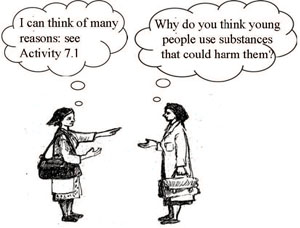
Activity 7.1
Make a list of reasons why young people use substances and compare your list with the list at the end of the study session.
One reason that young people do not worry about the possibility of substance abuse affecting their health is that they are not educated about the negative consequences. Giving them this education is a very important role for you.
7.4 Your role in prevention of substance abuse among young people
Most young people lack awareness of the negative consequences of substance use. Raising their awareness of the various ill effects of substances could help in the prevention of substance abuse.
Some young people may persist in substance use even if they are aware of the negative consequences. Helping them to think critically of the perceived effects of substances will help. Young people’s perceptions and expectations of substances includes pleasure, courage, relaxation and increase in sexual ability.
Do substances fulfill these expectations?
Most of the substances discussed in this study session have an adverse effect on sexual ability and also decrease fertility. Pleasure and relaxation does not last long and once the effect has worn off the user is left feeling worse than they did before. So mostly young people cannot get what they expect from substance use.
Involving young people themselves in the fight against substance use is important. The community should also be mobilised for successful prevention. It is good to use young persons to educate their peers on substance use (Figure 7.5).
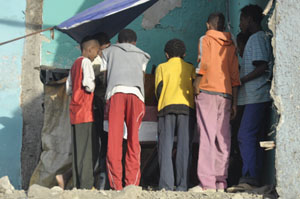
In Study Session 1 of this Module you learned that not all young people are equally at risk of reproductive health problems. For example, in Study Session 6 you learned that young girls in rural areas are particularly at risk of gender-based violence.
Who do you think are most likely to abuse alcohol:
- young boys or young girls?
- young people in school or young people out of school?
- those in rural areas or those in urban areas?
- young people who have been trafficked or those who are living with their families?
Young boys who are out of school and living without their families in urban areas are the most likely to abuse alcohol (and other substances).
These young men may be alone in urban areas because they have migrated in the hope of finding employment or they may have been trafficked. Many young people in Ethiopia are trafficked (Figure 7.6). Trafficking is a condition where young people are taken from their homes by people who intend to sell them to others. Sometimes the children are deceived and go willingly, other times they are taken by force. The young people suffer from exploitive labour, sexual exploitation, abuse and prostitution. Because they lose hope in this situation, most of them (girls as well as boys) engage in substance abuse.
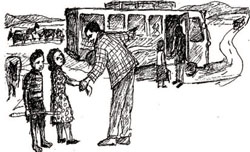
Migration brings both new possibilities and new risks to young people. Many young people from rural areas migrate to urban areas in search of better employment opportunities. Some of them succeed in getting jobs. However, some end up in the streets because they do not get the jobs they were hoping for and they have no one in the towns to support them (Figure 7.7). For both groups (those who get jobs and those who live in the streets), there are several risks that could affect their reproductive health. The fact that they are away from their home and families means they lack the traditional family influence and support when exposed to substance use.
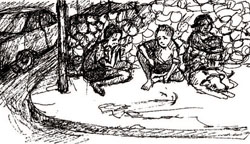
You as a health extension practitioner have many roles in reducing the risks of the most vulnerable groups in your community. In addition to raising awareness and supporting those who wish to quit their habit you may need to find opportunities to reach and educate young people who have dropped out of school. If they are thinking of migrating to the town you can provide counselling services on how to avoid substance use and also on protecting themselves from unwanted pregnancy and sexually transmitted infections. They should also learn of the dangers of HIV and how it can rapidly develop into AIDS with fatal consequences. Encourage them to be aware that psychoactive substances will impair their judgment and place them at multiple risk of impairing their health.
Summary of Study Session 7
In Study Session 7, you have learned that:
- Psychoactive substances that can alter mood and distort perceptions include: alcohol, khat, nicotine (found in cigarettes), cannabis (marijuana or hashish), cocaine, heroin and petrol fumes.
- Substance abuse can have negative economic, social, physical, psychological, and most importantly health consequences for young people.
- It can be difficult for young people to alter a habit of substance abuse as these substances can be addictive.
- Trafficking and migration may expose young people to various forms of abuse. When they perceive their situation as hopeless they may resort to substances.
- You can help to prevent substance abuse through a programme of education and support for those who wish to quit.
Self-Assessment Questions (SAQs) for Study Session 7
Now that you have completed this study session, you can assess how well you have achieved its Learning Outcomes by answering the questions below. Write your answers in your Study Diary and discuss them with your Tutor at the next Study Support Meeting. You can check your answers with the Notes on the Self-Assessment Questions at the end of this Module.
First read Case Study 7.1 and then answer the questions that follow it.
Case Study 7.1 Difficulties with Alemu
Alemu is a 19 year old man living in your community who uses khat and hashish. He also drinks a lot and often fights other community members when he gets drunk. He has multiple sexual partners and is not married. He stopped going to school because his school performance became very poor. Sometimes he steals to pay for the alcohol, khat and hashish. Although he has realised that substance abuse is affecting him adversely, he can’t quit consuming these substances. You are planning to initiate a community conversation programme in your community.
SAQ 7.1
Which of the substances that Alemu uses could badly affect his sexual and reproductive life? Explain your answers.
Answer
Alemu consumes alcohol, khat and the illicit substance hashish; he has already developed high-risk behaviours that could make him vulnerable to HIV infection. Long-term use of alcohol may make him infertile, long-term use of khat may be addictive and reduce his desire for sex. He may not be able to have a satisfactory orgasm when he uses hashish
SAQ 7.2
If Alemu realises that substance abuse is affecting him adversely why doesn’t he stop using alcohol, khat and hashish?
Answer
It seems that Alemu is already addicted to these substances as he knows they are bad for him but he can’t quit. If he tries to quit he will suffer withdrawal symptoms.
SAQ 7.3
What could you do to help Alemu?
Answer
Help him to think critically of his experiences with these substances and how they fail to fulfill his expectations. Engage him in the community conversation sessions; this will enable him to change his behaviour.
Notes on Activity 7.1
Young people may initially try substances because they are:
- curious
- pressured by their peers
- want to become part of the peer group
- looking for fun and entertainment
- unaware of the dangers to their health.
They may continue because:
- they think it will change them into someone different
- it gives them confidence to face different challenges
- to get away from their problems
- to cope with sadness
- to escape from hopelessness.